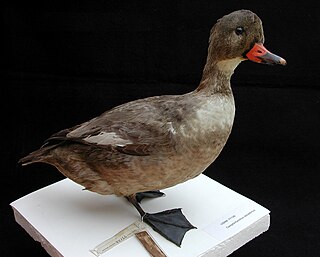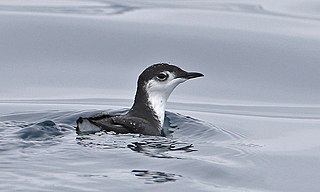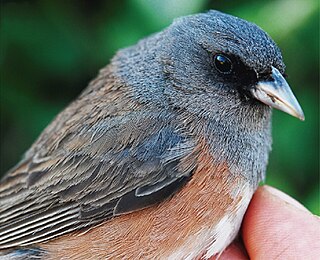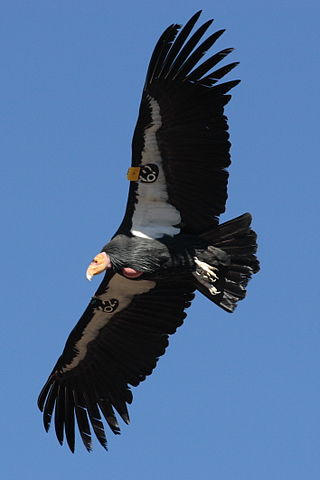
The Labrador duck is an extinct North American duck. It has the distinction of being the first known endemic North American bird species to become extinct after the Columbian Exchange, with the last known sighting occurring in 1878 in Elmira, New York. It was already a rare duck before European settlers arrived, and as a result of its rarity, information on the Labrador duck is not abundant, although some, such as its habitat, characteristics, dietary habits and reasons behind its extinction, are known. There are 55 specimens of the Labrador duck preserved in museum collections worldwide.

The falcons and caracaras are around 65 species of diurnal birds of prey that make up the family Falconidae. The family is divided into three subfamilies: Herpetotherinae, which includes the laughing falcon and forest falcons; Polyborinae, which includes the spot-winged falconet and the caracaras; and Falconinae, the falcons and kestrels (Falco) and falconets (Microhierax).

Northern storm petrels are seabirds in the genus Hydrobates in the family Hydrobatidae, part of the order Procellariiformes. The family was once lumped with the similar austral storm petrels in the combined storm petrels, but have been split, as they were not closely related. These smallest of seabirds feed on planktonic crustaceans and small fish picked from the surface, typically while hovering. Their flight is fluttering and sometimes bat-like.

The Moorea Sandpiper is an extinct member of the large wader family Scolopacidae that was endemic to Mo'orea in French Polynesia, where the locals called it te-te in the Tahitian language.

The crested shelduck, or Korean crested shelduck, is a species of bird in the family Anatidae. It is critically endangered and may be extinct. The male crested shelduck has a greenish-black crown, breast, primaries, and tail, while the rest of its face, chin, and throat are brownish black. The male's belly, undertail coverts, and flanks are a dark grey with black striations. The upper wing coverts are white, while its speculum is an iridescent green. The female has a white eye ring, black crest, white face, chin, throat, neck, and uppers wing coverts and a dark brown body with white striations. Additionally, both sexes have a distinctive green tuft of feathers protruding from the head.

Guadalupe Island is a volcanic island located 241 kilometres off the western coast of Mexico's Baja California Peninsula and about 400 km (200 nmi) southwest of the city of Ensenada in the state of Baja California, in the Pacific Ocean. The various volcanoes are extinct or dormant. In 2005 Guadalupe Island and its surrounding waters and islets were declared a biosphere reserve to restore its vegetation and to protect its population of marine mammals and birds. The island is a popular destination for great white shark cage diving. Guadalupe Island is inhabited only by scientists, military personnel operating a weather station, and a small group of seasonal fishermen. The island is mostly arid and has very little surface water.

The Guadalupe murrelet or Xantus's murrelet is a small seabird found in the California Current system in the Pacific Ocean. This auk breeds on islands off California and Mexico. It is threatened by predators introduced to its breeding colonies and by oil spills.

The Guadalupe storm petrel is a small seabird of the storm petrel family Hydrobatidae. It bred only on Guadalupe Island off Baja California, Mexico, and presumably ranged throughout the region. It has been assessed as Critically Endangered or possibly extinct.
The Mauke starling or mysterious starling is an extinct species of starling found on the island of Mauke, Cook Islands. The binomen is the result of Buller's misreading of the name inornata on the specimen label. As he seems to have genuinely believed this spelling to be correct, the binomial, although it has no meaning, is valid.

The Cuban macaw or Cuban red macaw is an extinct species of macaw native to the main island of Cuba and the nearby Isla de la Juventud. It became extinct in the late 19th century. Its relationship with other macaws in its genus was long uncertain, but it was thought to have been closely related to the scarlet macaw, which has some similarities in appearance. It may also have been closely related, or identical, to the hypothetical Jamaican red macaw. A 2018 DNA study found that it was the sister species of two red and two green species of extant macaws.

The Guadalupe junco is a small bird in the New World sparrow family that is endemic to Guadalupe Island off the western coast of Baja California, Mexico. Many taxonomic authorities classified it in 2008 as a subspecies of the dark-eyed junco. In 2016, it was re-classified as a full species.

The black-vented shearwater is a species of seabird. The bird is 30–38 cm in length with a 76–89 cm wingspan. Formerly considered a subspecies of the Manx shearwater, its actual taxonomic relationships are unresolved.

Coues's gadwall or the Washington Island gadwall, is an extinct dabbling duck which is only known by two immature specimens from the Pacific island of Teraina, Line Islands, Kiribati. They are in the National Museum of Natural History in Washington, D.C. The bird was named in honor of Elliott Coues.

The Grand Cayman thrush is an extinct bird from the thrush family (Turdidae). It was endemic to the island of Grand Cayman in the Caribbean.

The Bishop's ‘ō‘ō or Molokai ‘ō‘ō was the penultimate member of the extinct genus of the ‘ō‘ōs (Moho) within the extinct family Mohoidae. It was previously regarded as member of the Australo-Pacific honeyeaters (Meliphagidae). Lionel Walter Rothschild named it after Charles Reed Bishop, the founder of the Bishop Museum.
The Kosrae crake or Kusaie Island crake, sometimes also stated as Kittlitz's rail, is an extinct bird from the family Rallidae. It occurred on the island of Kosrae and perhaps on Ponape in the south-western Pacific which belong both to the Caroline Islands. Its preferred habitat were coastal swamps and marshland covered with taro plants.

The crested caracara, also known as the Mexican eagle, is a bird of prey in the family Falconidae. It is found throughout Central and South America but has been found in northern Minnesota to Tierra del Fuego. It was formerly placed in the genus Polyborus.

The O‘ahu ‘ō‘ō was a member of the extinct genus of the ‘ō‘ōs (Moho) within the extinct family Mohoidae. It was previously regarded as member of the Australo-Pacific honeyeaters (Meliphagidae).

Caracara is a genus in the family Falconidae and the subfamily Polyborinae. It contains one extant species, the crested caracara; and one extinct species, the Guadalupe caracara. The South American Classification Committee of the American Ornithological Society has voted to again merge the two, retaining C. plancus as crested caracara. The taxonomists of the International Ornithologists' Union have also merged them.

A large proportion of living species on Earth live a parasitic way of life. Parasites have traditionally been seen as targets of eradication efforts, and they have often been overlooked in conservation efforts. In the case of parasites living in the wild – and thus harmless to humans and domesticated animals – this view is changing. The conservation biology of parasites is an emerging and interdisciplinary field that recognizes the integral role parasites play in ecosystems. Parasites are intricately woven into the fabric of ecological communities, with diverse species occupying a range of ecological niches and displaying complex relationships with their hosts.



















